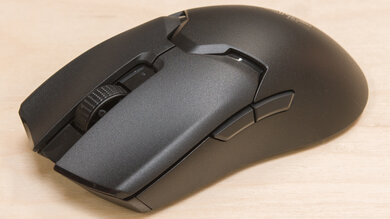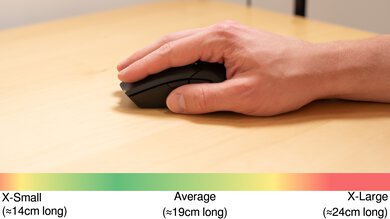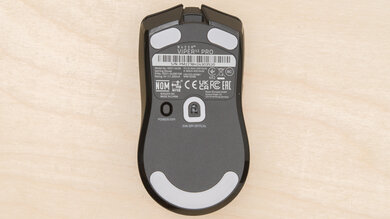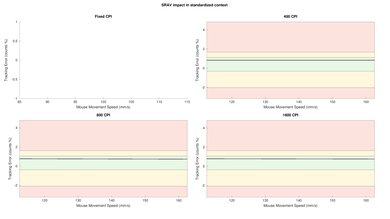The Razer Viper Mini Signature Edition is a lightweight, wireless gaming mouse in Razer's Viper lineup. This mouse shares the same shape as the original Razer Viper Mini but has an exposed exoskeleton design with a top shell made of magnesium alloy that Razer advertises provides the best strength-to-weight ratio compared to plastic and carbon fiber. Under the hood, this mouse uses similar high-end internals to other recent Razer flagship releases, including a Razer Focus Pro 30K sensor and Gen-3 optical switches. Additionally, this mouse comes with a Razer HyperSpeed Dongle that is unique to the Viper Mini Signature Edition. This dongle allows you to set a maximum wireless polling rate of 8000Hz, and it's the first wireless gaming mouse on the market to offer this feature.
This mouse was originally released exclusively on Razer's website and select physical Razer stores as a limited quantity drop. Razer has committed to continued production in batch drops according to demand, but as of the writing of this review, it's currently out of stock.
Our Verdict
The Razer Viper Mini Signature Edition is decent for office work but isn't designed specifically for this use. That said, it has outstanding build quality, and you can reprogram any of the buttons using the customization software. This mouse is best suited for small or medium-sized hands but may be less comfortable if you hold the mouse with your palm in contact with the exposed exoskeleton framework on the back of the mouse.
-
Remarkable build quality.
-
Doesn't support multi-device pairing.
-
Scroll wheel lacks a free-scrolling mode and L/R tilt inputs.
The Razer Viper Mini Signature Edition is an exceptional FPS gaming mouse. It's extremely lightweight, and its magnesium alloy body feels very sturdy. Performance-wise, its click latency is incredibly low and consistent, and both sensor accuracy and latency are superb. Additionally, this mouse supports a maximum wireless polling rate of 8000Hz, which provides marginally better and much more consistent overall performance at the cost of significant CPU power draw and battery life drain. This mouse offers a remarkably smooth, accurate, and immediate FPS gaming experience.
-
Remarkable build quality.
-
Exceptional sensor performance.
-
Exceptionally low click latency.
-
Maximum wireless polling rate of 8000Hz.
The Razer Viper Mini Signature Edition is very good for MMO gaming but has fewer side buttons than a dedicated MMO gaming mouse. That being said, you can program any of the buttons using the customization software. It also has outstanding build quality and feels very sturdy. Performance-wise, it has remarkably low and consistent click latency, outstanding sensor performance, and support for wireless polling rates higher than 1000Hz.
-
Remarkable build quality.
-
Exceptional sensor performance.
-
Exceptionally low click latency.
-
Scroll wheel lacks L/R tilt inputs.
-
Has fewer side buttons than a dedicated MMO gaming mouse.
The Razer Viper Mini Signature Edition provides outstanding raw performance. Its click latency is incredibly low, and both the sensor latency and accuracy are superb. Additionally, this mouse is the first on the market to offer a maximum wireless polling rate of 8000Hz, delivering slightly better but much more consistent overall performance. However, using the 8000Hz polling rate also requires considerable CPU resources and consumes battery power much more quickly.
-
Exceptional sensor performance.
-
Exceptionally low click latency.
-
Maximum wireless polling rate of 8000Hz.
- Work
- Video Games (FPS)
- Video Games (MMO)
- Raw Performance
- Updated May 16, 2024: We've added a link to the newly-reviewed Keychron M4 in the Hand Size Recommendation section of this review.
- Updated Feb 22, 2024: We've added a link to the newly-reviewed WLmouse BEAST X in the Weight section of this review.
- Updated Feb 06, 2024: We've added a link to the newly reviewed G-Wolves HSK Pro 4K in the Hand Size Recommendation section of this review.
- Updated Jan 10, 2024: We've updated the CPI graph displayed in the Sensor Latency section of this review. Our results remain the same, but these graphs have two new columns with results from the Delay At Half Movement and Delay To End Of Movement tests.
- Updated Jan 05, 2024: We've added a link to the newly-reviewed Finalmouse UltralightX in the Weight section of this review.
- Updated Nov 24, 2023: We've converted this review to Test Bench 1.5. This update adds a new Main Button test group, which provides button actuation data and switch information. We've also made minor changes to how we calculate the Office usage score. For more details, you can see our full changelog here.
- Updated Sep 25, 2023: We previously incorrectly stated that this mouse works on glass when, in fact, it doesn't. The review has been updated to reflect this change.
- Updated Jul 06, 2023: Review published.
- Updated Jun 23, 2023: Early access published.
- Updated Jun 21, 2023: Our testers have started testing this product.
- Updated Jun 06, 2023: The product has arrived in our lab, and our testers will start evaluating it soon.
- Updated May 03, 2023: We've purchased the product and are waiting for it to arrive in our lab.
- Updated Mar 13, 2023: The product has won our suggestion poll, so we'll buy and test it soon.
Differences Between Sizes And Variants
This mouse is only available in a black color option and has no variants at the time of writing. You can see the label for the unit we bought and tested here.
Razer has indicated that it doesn't intend this mouse to be a one-off limited edition and will continue to release small quantity batch drops according to demand. Razer has a form on their product page that you can fill out if you want to be notified when this mouse is in stock for purchase.
Compared To Other Mice
The Razer Viper Mini Signature Edition shares virtually the same shape as the original Razer Viper Mini but is fundamentally different in most other ways. In contrast, the original Viper Mini is a wired gaming mouse between a mid-range or budget price point. However, the Razer Viper Mini Signature Edition is considerably more expensive than most gaming mice, including Razer's current flagships. This mouse is the first Razer mouse with a magnesium alloy exoskeleton body and the first commercially available gaming mouse to support a maximum wireless polling rate of 8000Hz.
This mouse bears conceptual similarities with the mice in the Finalmouse Starlight lineup and weighs virtually the same as medium-size variants, like the Finalmouse Starlight Pro Tenz Medium. The Razer Viper Mini Signature Edition also uses the same top-of-the-line sensor as recent Razer flagships, like the Razer Viper V2 Pro and the Razer DeathAdder V3 Pro. However, the Viper Mini Signature Edition surpasses these mice in terms of overall performance, thanks in part to its wireless maximum polling rate of 8000Hz, which provides more consistent and marginally better latency and sensor performance. Although, using the maximum polling rate of 8000Hz also comes at a significant cost in terms of battery life and required CPU processing power. While this mouse delivers exceptional wireless gaming performance, it also carries a significantly higher price tag than most premium wireless gaming mice. Razer has stated that it plans to release this mouse in small, irregular batch drops, so it may be difficult to find available, depending on when you're reading this.
For more recommendations, see our picks for the best gaming mouse, the best wireless gaming mouse, and the best Razer mouse.
The Razer Viper V2 Pro and the Razer Viper Mini Signature Edition are lightweight wireless gaming mice in the same product lineup. The Viper V2 Pro is larger and has a solid plastic body. On the other hand, the Viper Mini Signature Edition is smaller, lighter, and has a magnesium alloy exoskeleton body. The Signature Edition also includes a paired Razer HyperSpeed Dongle that allows a maximum wireless polling rate of 8000Hz. At the same time, the Viper V2 Pro, by default, only supports a maximum wireless polling rate of 1000Hz. The Viper V2 Pro can support a maximum wireless polling rate of 8000Hz using a Razer HyperSpeed Dongle, although one is not included in the box.
The Razer Viper Mini Signature Edition and the WLmouse BEAST X are both wireless gaming mice that have exoskeleton body designs made of magnesium alloy, making them both extremely lightweight and sturdy. The Razer has slightly better overall raw gaming performance, and its build quality feels somewhat better and more premium overall. Comparatively, the WLmouse is available in a range of colors, while the Razer is not. Additionally, the WLmouse has been continuously in stock at the time of writing, while the Razer is only being released in small, periodic batches.
The Razer Viper Mini and the Razer Viper Mini Signature Edition are gaming mice with the same dimensions in the same product lineup. The Viper Mini is a wired model with a solid plastic body. On the other hand, the Viper Mini Signature Edition is a lighter wireless model with a magnesium alloy exoskeleton body. The Signature Edition also has considerably better gaming performance and supports a maximum wireless polling rate of 8000Hz.
The Logitech G PRO X SUPERLIGHT and the Razer Viper Mini Signature Edition are lightweight wireless gaming mice. The Logitech is larger and has a solid plastic body. On the other hand, the Razer is smaller, lighter, and has a magnesium alloy exoskeleton body. The Razer also provides better overall latency and sensor performance and supports a maximum wireless polling rate of 8000Hz.
The Razer Viper Mini Signature Edition and the Finalmouse UltralightX are lightweight wireless gaming mice with similar symmetrical shapes and body designs with weight-saving cutouts. The Razer has marginally better overall sensor performance. It's also somewhat heavier, and its body is made of magnesium alloy. Conversely, the Finalmouse model has marginally lower click latency performance, and its body is made of a carbon fiber composite, making it somewhat lighter.
The Razer Viper 8KHz and the Razer Viper Mini Signature Edition are gaming mice in the same product lineup that support 8000Hz polling rates. The Viper 8KHz is a larger, wired-only model. On the other hand, the Viper Mini Signature Edition is a wireless model that's significantly lighter and has a magnesium alloy exoskeleton body.
The Razer Viper Mini Signature Edition and the Endgame Gear OP1 8k are enthusiast-geared gaming mice. Both have superb raw performance and support 8000Hz polling rates. The biggest difference is that the Razer is a wireless model. It also has a magnesium alloy body with triangle-shaped cutouts and uses optical switches. On the other hand, the OP1 8k is a wired-only model. It has a solid plastic shell, and while it has marginally worse sensor performance, it has slightly better click latency.
The Finalmouse Starlight Pro-TenZ Medium and the Razer Viper Mini Signature Edition are lightweight wireless gaming mice with partially open magnesium alloy bodies. Both mice weigh virtually the same, but the Razer has significantly better sensor and latency performance. The Razer also supports a maximum wireless polling rate of 8000Hz, while the Finalmouse supports a maximum polling rate of 1000Hz.
The Keychron M4 and the Razer Viper Mini Signature Edition are lightweight wireless gaming mice. The Keychron has a very small shape that's designed exclusively for fingertip grip. In contrast, the Razer has a much more conventional shape but employs an exoskeleton-like magnesium shell designed to save weight. Both mice have excellent performance, but the Razer has a higher maximum polling rate of 8000Hz compared to the Keychron's 4000Hz maximum, contributing to its better overall raw performance.
The G-Wolves HSK Pro 4K and the Razer Viper Mini Signature Edition are extremely lightweight, high-performance wireless gaming mice. While the Razer has a more conventional symmetrical shape, the G-Wolves has a very small shape designed specifically for a fingertip grip. As a result, it's much lighter than the Razer. On the other hand, the Razer has much better build quality than the G-Wolves, and it's constructed using a lightweight magnesium alloy. The Razer also has lower sensor latency.
Video
Test Results
This mouse has a black, anodized magnesium alloy body with an exoskeleton-like framework on the top that extends from the bottom of the left-and right-click buttons onto the back half of the mouse. The scroll wheel is made of metal and has a lighter gunmetal color. The word 'Razer' is written on the left-click button, and a written slogan: "For Gamers by Gamers' is visible inside the exoskeleton body towards the mouse's heel.
This mouse doesn't have any RGB lighting zones, but there's a small LED light inside the mouse that flashes a color when switching between CPI settings.
This mouse shares virtually the same dimensions as the original Razer Viper Mini. It's approximately 1mm smaller in overall length and width, but the two shapes feel identical in hand.
This mouse isn't designed specifically with portability in mind. While it isn't very big, it's fairly bulky and lacks any internal compartment for storing the wireless Razer HyperPolling Dongle.
This mouse has outstanding build quality. The top shell is made of magnesium alloy and feels sturdy in hand, and the bottom plate is solid plastic. The top shell doesn't flex or make any creaking noises, even with considerable pressure applied. The left- and right-click buttons have minimal side-to-side travel, but there aren't any grinding or alignment issues and no issues present when using the mouse as intended. There's some minor flexibility on the plastic bottom plate where the label sticker is placed, but once more, this is minor and doesn't impact normal use.
This mouse is remarkably lightweight in its default configuration and has a marginal front-heavy weight distribution. This mouse is approximately 10 grams lighter than the original Razer Viper Mini.
The adhesive grip tape included in the box will add up to a couple of grams to the total weight if used.
If you're interested in a wireless gaming mouse that's even more lightweight with a similar size and shape, check out our review of the Finalmouse UltralightX or the WLmouse BEAST X.
This mouse has a low-profile, symmetrical shape with two side buttons on the left and is virtually identical in dimensions to the original Razer Viper Mini. Much like its predecessor, this mouse is best suited for small or medium-sized hands and ideal for a fingertip grip.
The shape and size of this mouse also make it suitable for a claw or, to a lesser degree, a palm grip, but it isn't as comfortable for these grip types due to palm contact with the irregular exoskeleton framework on the back hump of the mouse.
The magnesium alloy body of this mouse is smoother than the plastic body of the original Viper Mini and may feel somewhat slippery for some. That said, adhesive grips included in the box can provide added grip.
If you're looking for a similarly ultra-lightweight mouse but exclusively use a fingertip grip, check out the G-Wolves HSK Pro 4K or the Keychron M4.
Razer advertises that this mouse has a battery life of up to 60 hours using a polling rate of 1000Hz, or up to 12 hours using a polling rate of 8000Hz.
Razer also advertises that this mouse supports a 2C fast charging rate that can fully recharge the mouse in 90 minutes.
Note: Razer indicates the HyperPolling Dongle included with this mouse is programmed specifically for the Razer Viper Mini Signature Edition and can't be unpaired and paired with other Razer mice.

This mouse has a lightweight, flexible paracord-like charging cable that produces minimal drag across desks. It retains minor only minor kinks from how it's packaged.
This mouse has exceptional feet that glide very easily on hard and soft mousepads and directly on desks.
This mouse was tested with the stock PTFE feet, but an alternate set of glass mouse feet made of Corning Gorilla Glass 3 is included in the box. We expect these feet to glide with less friction on mousepads and desks, but they may also feel too sensitive and not provide enough control for some, depending on your personal preferences and the mousepad you use.
- Razer Viper Mini Signature Edition
- Razer HyperPolling Wireless Dongle
- USB-A to USB-C charging cable
- 1x replacement PTFE mouse feet
- 1x set of glass mouse feet (Corning Gorilla Glass 3)
- 2x Alcohol Prep Pads
- Adhesive grip tape
- Microfiber cloth
- Stickers
- User documentation
You can reprogram all of the buttons on the Razer Viper Mini Signature Edition using the customization software, including the button on the bottom, which by default, allows you to cycle between CPI settings.
Additionally, you can assign a Hypershift button to program a secondary layer of inputs.
The left- and right-click buttons use Razer's Gen-3 optical switches with an advertised rating of 90 million clicks.

The Razer Viper Mini Signature Edition's click latency is remarkably low and exceptionally consistent. It provides an extremely responsive-feeling experience for gaming in any genre and at any competitive level.
This latency of this mouse was tested at the maximum wired polling rate of 1000Hz and the maximum wireless polling rate setting of 8000Hz.

The Razer Viper Mini Signature Edition has exceptional CPI performance. Its sensor delivers outstanding tracking accuracy, and the physical movements you make with your mouse translate extremely close to your cursor movements on-screen.
This mouse was tested at the maximum polling rate setting of 8000Hz.

The Razer Viper Mini Signature Edition has remarkable sensor latency performance. The sensor reacts exceptionally quickly when you move your mouse, and these movements almost perfectly match the timing of the cursor movements you see on the screen.
This mouse was tested at the maximum polling rate setting of 8000Hz.
The available wireless polling rate settings when the mouse is used wirelessly and paired with the Razer HyperSpeed Dongle are 125Hz, 500Hz, 1000Hz, 2000Hz, 4000Hz, and 8000Hz.
When Razer Viper Mini Signature Edition first launched, the maximum polling rate was 4000Hz, but Razer released a firmware update in April 2023 that upgraded the maximum wireless polling rate to 8000Hz.
The maximum polling rate is 1000Hz when using this mouse wired.
This mouse's scroll wheel is made of lightweight, grooved metal. Scrolling is quiet and feels quite smooth, but the individual steps are well-defined, and the scroll click has satisfying tactility.

The noise produced by the left and right mouse clicks, the side buttons, and the scroll click button is on the louder side and slightly louder than the original Razer Viper Mini.

This mouse uses Razer's Synapse 3 software, which is well laid out and generally easy to navigate. This software allows you to change various expected options, including CPI, button programming, polling rate, lift-off distance, surface calibration, and custom profile settings.
However, much like similar software options from other major manufacturers, this software is the source of criticism from the broader community. While we didn't experience any issues during the testing of this mouse, many users online criticize this software for requiring frequent updates and taking up disproportionate system resources, among other complaints. This software may be frustrating if you prefer more lightweight software options or no software at all.














